Integrating Spatiotemporal Analysis of Land Transformation and Urban Growth in Peshawar Valley and Its Implications on Temperature in Response to Climate Change
Abstract
1. Introduction
- (1)
- To analyze the spatiotemporal dynamics of land use and land cover (LULC) in the Peshawar Valley from 1990 to 2020, with a specific emphasis on alterations in built-up areas and their driving forces.
- (2)
- To evaluate the correlation between urbanization, population growth, and the expansion of built-up areas in the Peshawar Valley, aiming to comprehend the interconnection among these factors.
- (3)
- To examine the fluctuations in the land surface temperature (LST) over the three-decade period within the region and analyze the consequences of increasing temperature on the environment and human activities.
- (4)
- To investigate the influences of changing weather patterns, including temperature and humidity, on the heat index (HI) and to evaluate the potential health and environmental hazards associated with these variations in the Peshawar Valley.
2. Materials and Methods
2.1. Study Area
2.2. Data Collection
2.2.1. Landsat Data
2.2.2. Weather Data
2.2.3. Population Data, Vehicle Data, and Industry Data
2.2.4. Air Quality Data
2.3. Preprocessing, Classification, and Accuracy Assessment
2.4. Land Surface Temperature (LST) Retrieval
2.4.1. Google Earth Engine Description
2.4.2. Atmospheric Correction and Retrieval of LST
2.4.3. Pseudo-Code or Algorithm for LST Retrieval
| Algorithm 1 Land Surface Temperature Using GEE |
| Require Input: Landsat images set: I Ensure Output: Land Surface Temperature: T Start Initialization: 1. GEE ← Initialize Google Earth Engine 2. S ← Export shape files to GEE 3. R ← Run GEE Catalog of I (Surface Reflectance Collection) 4. ROI ← Specify region of interest (ROI) based on S 5. LST ← Set LST file export parameters Preprocessing LST: 6. SR ← Select I from R 7. ER ← Extract the ROI from I 8. M ← Create mask layer function to mask clouds, shadows, and saturated pixels 9. Apply filter on ER for additional quality assessment (optional) 10. Trange ← Mention the period or date range for the analysis 11. Apply filter and DOS method for Quality Assessment and atmospheric correction Processing LST: 12. for each image I in ER do 13. Apply filter on I for quality assessment 14. T ∞ ← Temperature value from image I 15. Tl ← Calculate Land Surface Temperature Post-processing and Visualization of LST: 16. MT ← Generate mean temperature for the whole year//Time series Analysis 17. Display MT in a chart along with Spatial Map with LST Temperature in CSV file 18. Export the results to Google Drive END |
2.5. Analyzing Climatic Data to Determine Heat Index Patterns
3. Results
- 3.1. Land Use and Land Cover (LULC) Dynamics: This section analyzes the changes in land use and land cover over time, including the dynamics of built-up areas.
- 3.2. Land Surface Temperature (LST) Variations: This section examines the variations in land surface temperature using Landsat imagery from 1990 to 2020.
- 3.3. Air Quality and Industrial/Vehicular Emissions: This section analyzes the air quality data and their relationship with industrial and vehicular emissions.
- 3.4. Weather Data and Heat Index: This section investigates the variations in weather data and their effect on the heat index from 1990 to 2020. It further explores the impact of air quality and emission factors on the heat index dynamics and analyzes the correlation between the heat index and population, built-up areas, vehicles, industrial activity, and climatic data.
3.1. Land Use and Land Cover (LULC) Dynamics
Dynamics in Built-Up Areas
3.2. Land Surface Temperature (LST) Variations using Landsat Imagery from 1990–2020
3.3. Analysis of Air Quality and Relationship with Industrial and Vehicular Emissions
3.4. Variations in Weather Data and Effect on Heat Index from 1990–2020
3.4.1. Heat Index Dynamics: Exploring the Impact of Air Quality and Emission Factors
3.4.2. Correlation between HI and Population, Built-Up Area, Vehicle, Industrial, and Climatic Data
4. Discussion
- Highlighting the importance of the HI as a metric for understanding the combined effects of urbanization and climate change on human health and thermal comfort.
- Providing valuable data for urban planners and policymakers in developing sustainable strategies to mitigate the negative environmental consequences of urbanization in the Peshawar Valley.
5. Conclusions
Author Contributions
Funding
Data Availability Statement
Acknowledgments
Conflicts of Interest
References
- Ramzan, M.; Saqib, Z.A.; Hussain, E.; Khan, J.A.; Nazir, A.; Dasti, M.Y.S.; Ali, S.; Niazi, N.K. Remote sensing-based prediction of temporal changes in land surface temperature and land use-land cover (LULC) in urban environments. Land 2022, 11, 1610. [Google Scholar] [CrossRef]
- Georgati, M.; Hansen, H.S.; Keßler, C. Random Forest Variable Importance Measures for Spatial Dynamics: Case Studies from Urban Demography. ISPRS Int. J. Geo-Inf. 2023, 12, 460. [Google Scholar] [CrossRef]
- Gu, D.; Andreev, K.; Dupre, M.E. Major trends in population growth around the world. China CDC Wkly. 2021, 3, 604. [Google Scholar] [CrossRef]
- Selod, H.; Shilpi, F. Rural-urban migration in developing countries: Lessons from the literature. Reg. Sci. Urban Econ. 2021, 91, 103713. [Google Scholar] [CrossRef]
- Zhai, H.; Lv, C.; Liu, W.; Yang, C.; Fan, D.; Wang, Z.; Guan, Q. Understanding spatio-temporal patterns of land use/land cover change under urbanization in Wuhan, China, 2000–2019. Remote Sens. 2021, 13, 3331. [Google Scholar] [CrossRef]
- Mumtaz, F.; Tao, Y.; de Leeuw, G.; Zhao, L.; Fan, C.; Elnashar, A.; Bashir, B.; Wang, G.; Li, L.; Naeem, S.; et al. Modeling spatio-temporal land transformation and its associated impacts on land surface temperature (LST). Remote Sens. 2020, 12, 2987. [Google Scholar] [CrossRef]
- Güneralp, B.; Zhou, Y.; Ürge-Vorsatz, D.; Gupta, M.; Yu, S.; Patel, P.L.; Fragkias, M.; Li, X.; Seto, K.C. Global scenarios of urban density and its impacts on building energy use through 2050. Proc. Natl. Acad. Sci. USA 2017, 114, 8945–8950. [Google Scholar] [CrossRef] [PubMed]
- Ziter, C.D.; Pedersen, E.J.; Kucharik, C.J.; Turner, M.G. Scale-Dependent Interactions between Tree Canopy Cover and Impervious Surfaces Reduce Daytime Urban Heat during Summer. Proc. Natl. Acad. Sci. USA 2019, 116, 7575–7580. [Google Scholar] [CrossRef]
- Alexander, C. Influence of the Proportion, Height and Proximity of Vegetation and Buildings on Urban Land Surface Temperature. Int. J. Appl. Earth Obs. Geoinf. 2021, 95, 102265. [Google Scholar] [CrossRef]
- Wemegah, C.S.; Yamba, E.I.; Aryee, J.N.A.; Sam, F.; Amekudzi, L.K. Assessment of Urban Heat Island Warming in the Greater Accra Region. Sci. Afr. 2020, 8, e00426. [Google Scholar] [CrossRef]
- Yang, J.; Zhan, Y.; Xiao, X.; Xia, J.C.; Sun, W.; Li, X. Investigating the Diversity of Land Surface Temperature Characteristics in Different Scale Cities Based on Local Climate Zones. Urban Clim. 2020, 34, 100700. [Google Scholar] [CrossRef]
- Hussain, M.; Liu, G.; Yousaf, B.; Ahmed, R.; Uzma, F.; Ali, M.U.; Ullah, H.; Butt, A.R. Regional and sectoral assessment on climate-change in Pakistan: Social norms and indigenous perceptions on climate-change adaptation and mitigation in relation to global context. J. Clean. Prod. 2018, 200, 791–808. [Google Scholar] [CrossRef]
- Swamy, G.S.; Nagendra, S.M.; Schlink, U. Impact of Urban Heat Island on Meteorology and Air Quality at Microenvironments. J. Air Waste Manag. Assoc. 2020, 70, 876–891. [Google Scholar] [CrossRef]
- Fu, P.; Weng, Q. A Time Series Analysis of Urbanization Induced Land Use and Land Cover Change and Its Impact on Land Surface Temperature with Landsat Imagery. Remote Sens. Environ. 2016, 175, 205–214. [Google Scholar] [CrossRef]
- Wang, H.; Liu, X.; Zhao, C.; Chang, Y.; Liu, Y.; Zang, F. Spatial-temporal pattern analysis of landscape ecological risk assessment based on land use/land cover change in Baishuijiang National nature reserve in Gansu Province, China. Ecol. Indic. 2021, 124, 107454. [Google Scholar] [CrossRef]
- Xiang, T.; Meng, X.; Wang, X.; Xiong, J.; Xu, Z. Spatiotemporal Changes and Driving Factors of Ecosystem Health in the Qinling-Daba Mountains. ISPRS Int. J. Geo-Inf. 2022, 11, 600. [Google Scholar] [CrossRef]
- He, W.; Zhang, L.; Yuan, C. Future air temperature projection in high-density tropical cities based on global climate change and urbanization–a study in Singapore. Urban Clim. 2022, 42, 101115. [Google Scholar] [CrossRef]
- Tumse, S.; Bilgili, M.; Sekertekin, A.; Ünal, Ş.; Sahin, B. Comparison and evaluation of machine learning approaches for estimating heat index map in Türkiye. Neural Comput. Appl. 2023, 35, 15721–15742. [Google Scholar] [CrossRef]
- Ghalhari, G.F.; Dehghan, S.F.; Shakeri, F.; Ghanadzadeh, M.J.; Asghari, M. Assessing the monthly changes of heat stress indices in outdoor environment during a 15-year period: Case of study in a dry and warm climate. Urban Clim. 2020, 31, 100538. [Google Scholar] [CrossRef]
- Zune, M.; Rodrigues, L.; Gillott, M. The vulnerability of homes to overheating in Myanmar today and in the future: A heat index analysis of measured and simulated data. Energy Build. 2020, 223, 110201. [Google Scholar] [CrossRef]
- Aksu, O.; Iban, M.C. Considerations on the Land Management System Approach in Turkey by the Experiences of a Case Study. Surv. Rev. 2019, 51, 87–96. [Google Scholar] [CrossRef]
- Hill, A.C.; Laugier, E.J.; Casana, J. Archaeological remote sensing using multi-temporal, drone-acquired thermal and Near Infrared (NIR) Imagery: A case study at the Enfield Shaker Village, New Hampshire. Remote Sens. 2020, 12, 690. [Google Scholar] [CrossRef]
- Shao, Z.; Wu, W.; Li, D. Spatio-temporal-spectral observation model for urban remote sensing. Geo-Spat. Inf. Sci. 2021, 24, 372–386. [Google Scholar] [CrossRef]
- Kafy, A.-A.; Naim, N.H.; Khan, M.H.H.; Islam, M.A.; Al Rakib, A.; Al-Faisal, A.; Sarker, M.H.S. Prediction of Urban Expansion and Identifying Its Impacts on the Degradation of Agricultural Land. In Re-Envisioning Remote Sensing Applications; CRC Press: Boca Raton, FL, USA, 2021; pp. 85–106. [Google Scholar]
- Ullah, S.; Ahmad, K.; Sajjad, R.U.; Abbasi, A.M.; Nazeer, A.; Tahir, A.A. Analysis and simulation of land cover changes and their impacts on land surface temperature in a lower Himalayan region. J. Environ. Manag. 2019, 245, 348–357. [Google Scholar] [CrossRef]
- Yao, N.; Huang, C.; Yang, J.; Konijnendijk van den Bosch, C.C.; Ma, L.; Jia, Z. Combined effects of impervious surface change and large-scale afforestation on the surface urban heat island intensity of Beijing, China based on remote sensing analysis. Remote Sens. 2020, 12, 3906. [Google Scholar] [CrossRef]
- Saha, S.; Saha, A.; Das, M.; Saha, A.; Sarkar, R.; Das, A. Analyzing spatial relationship between land use/land cover (LULC) and land surface temperature (LST) of three urban agglomerations (UAs) of Eastern India. Remote Sens. Appl. Soc. Environ. 2021, 22, 100507. [Google Scholar] [CrossRef]
- Hemati, M.; Hasanlou, M.; Mahdianpari, M.; Mohammadimanesh, F. A systematic review of landsat data for change detection applications: 50 years of monitoring the earth. Remote Sens. 2021, 13, 2869. [Google Scholar] [CrossRef]
- Wulder, M.A.; Roy, D.P.; Radeloff, V.C.; Loveland, T.R.; Anderson, M.C.; Johnson, D.M.; Healey, S.; Zhu, Z.; Scambos, T.A.; Pahlevan, N.; et al. Fifty years of Landsat science and impacts. Remote Sens. Environ. 2022, 280, 113195. [Google Scholar] [CrossRef]
- Liu, Y.; Song, W.; Deng, X. Understanding the spatiotemporal variation of urban land expansion in oasis cities by integrating remote sensing and multi-dimensional DPSIR-based indicators. Ecol. Indic. 2019, 96, 23–37. [Google Scholar] [CrossRef]
- Radočaj, D.; Obhođaš, J.; Jurišić, M.; Gašparović, M. Global open data remote sensing satellite missions for land monitoring and conservation: A review. Land 2020, 9, 402. [Google Scholar] [CrossRef]
- Mallick, S.K.; Das, P.; Maity, B.; Rudra, S.; Pramanik, M.; Pradhan, B.; Sahana, M. Understanding future urban growth, urban resilience and sustainable development of small cities using prediction-adaptation-resilience (PAR) approach. Sustain. Cities Soc. 2021, 74, 103196. [Google Scholar] [CrossRef]
- Mubako, S.; Nnko, H.J.; Peter, K.H.; Msongaleli, B. Evaluating historical and predicted long-term land use/land-cover change in Dodoma Urban District, Tanzania: 1992–2029. Phys. Chem. Earth Parts A/B/C 2022, 128, 103205. [Google Scholar] [CrossRef]
- Marzouk, M.; Othman, A. Planning utility infrastructure requirements for smart cities using the integration between BIM and GIS. Sustain. Cities Soc. 2020, 57, 102120. [Google Scholar] [CrossRef]
- Pacheco-Torres, R.; Roldán, J.; Gago, E.J.; Ordóñez, J. Assessing the relationship between urban planning options and carbon emissions at the use stage of new urbanized areas: A case study in a warm climate location. Energy Build. 2017, 136, 73–85. [Google Scholar] [CrossRef]
- Litman, T. Determining optimal urban expansion, population and vehicle density, and housing types for rapidly growing cities. In Proceedings of the World Conference on Transport Research, Shanghai, China, 10–15 July 2016; pp. 10–15. [Google Scholar]
- WoldeYohannes, A.; Cotter, M.; Kelboro, G.; Dessalegn, W. Land use and land cover changes and their effects on the landscape of Abaya-Chamo Basin, Southern Ethiopia. Land 2018, 7, 2. [Google Scholar] [CrossRef]
- Akbar, T.A.; Hassan, Q.K.; Ishaq, S.; Batool, M.; Butt, H.J.; Jabbar, H. Investigative spatial distribution and modelling of existing and future urban land changes and its impact on urbanization and economy. Remote Sens. 2019, 11, 105. [Google Scholar] [CrossRef]
- Yu, M.; Yang, Y.; Chen, F.; Zhu, F.; Qu, J.; Zhang, S. Response of agricultural multifunctionality to farmland loss under rapidly urbanizing processes in Yangtze River Delta. China Sci. Total Environ. 2019, 666, 1–11. [Google Scholar] [CrossRef]
- Penghui, J.; Dengshuai, C.; Manchun, L. Farmland landscape fragmentation evolution and its driving mechanism from rural to urban: A case study of Changzhou City. J. Rural Stud. 2021, 82, 1–18. [Google Scholar] [CrossRef]
- Hou, D.; Meng, F.; Prishchepov, A.V. How is urbanization shaping agricultural land-use? Unraveling the nexus between farmland abandonment and urbanization in China. Landsc. Urban Plan 2021, 214, 104170. [Google Scholar] [CrossRef]
- Olorunfemi, I.E.; Fasinmirin, J.T.; Olufayo, A.A.; Komolafe, A.A. GIS and remote sensing-based analysis of the impacts of land use/land cover change (LULCC) on the environmental sustainability of Ekiti State, southwestern Nigeria. Environ. Dev. Sustain. 2020, 22, 661–692. [Google Scholar] [CrossRef]
- Karakuş, C.B. The impact of land use/land cover (LULC) changes on land surface temperature in Sivas City Center and its surroundings and assessment of Urban Heat Island. Asia-Pac. J. Atmos. Sci. 2019, 55, 669–684. [Google Scholar] [CrossRef]
- Imran, H.M.; Hossain, A.; Shammas, M.I.; Das, M.K.; Islam, M.R.; Rahman, K.; Almazroui, M. Land surface temperature and human thermal comfort responses to land use dynamics in Chittagong city of Bangladesh. Geomat. Nat. Hazards Risk 2022, 13, 2283–2312. [Google Scholar] [CrossRef]
- Mehmood, K.; Bao, Y.; Petropoulos, G.P.; Abbas, R.; Abrar, M.M.; Saifullah; Mustafa, A.; Soban, A.; Saud, S.; Ahmad, M.; et al. Investigating connections between COVID-19 pandemic, air pollution and community interventions for Pakistan employing geoinformation technologies. Chemosphere 2021, 272, 129809. [Google Scholar] [CrossRef]
- Anwar, M.N.; Shabbir, M.; Tahir, E.; Iftikhar, M.; Saif, H.; Tahir, A.; Murtaza, M.A.; Khokhar, M.F.; Rehan, M.; Aghbashlo, M.; et al. Emerging challenges of air pollution and particulate matter in China, India, and Pakistan and mitigating solutions. J. Hazard. Mater. 2021, 416, 125851. [Google Scholar] [CrossRef]
- Ahmed, T.; Zounemat-Kermani, M.; Scholz, M. Climate change, water quality and water-related challenges: A review with focus on Pakistan. Int. J. Environ. Res. Public Health 2020, 17, 8518. [Google Scholar] [CrossRef]
- Air IQ. World Air Quality Report. Region & City PM2.5. 2019. Available online: https://www.iqair.com/world-most-polluted-cities/world-air-quality-report-2019-en.pdf (accessed on 18 November 2023).
- Tollefson, J. The 2 C dream. Nature 2015, 527, 436. [Google Scholar] [CrossRef]
- Mansourian, S.; Berrahmouni, N. Review of Forest and Landscape Restoration in Africa 2021; Food & Agriculture Organization: Rome, Italy, 2021.
- Zhai, J.; Wang, L.; Liu, Y.; Wang, C.; Mao, X. Assessing the effects of China’s three-north shelter forest program over 40 years. Sci. Total Environ. 2023, 857, 159354. [Google Scholar] [CrossRef]
- De Pinto, A.; Cenacchi, N.; Robertson, R.; Kwon, H.-Y.; Thomas, T.; Koo, J.; Begeladze, S.; Kumar, C. The role of crop production in the forest landscape restoration approach—Assessing the potential benefits of meeting the Bonn Challenge. Front. Sustain. Food Syst. 2020, 4, 61. [Google Scholar] [CrossRef]
- Pakistan Bureau of Statistics. The Population of Pakistan Reaches 241.49 Million as the Digital Census Concludes. Available online: https://www.pbs.gov.pk/sites/default/files/population/2023/Press%20Release.pdf (accessed on 18 September 2023).
- Mumtaz, F.; Li, J.; Liu, Q.; Tariq, A.; Arshad, A.; Dong, Y.; Zhao, J.; Bashir, B.; Zhang, H.; Gu, C. Impacts of green fraction changes on surface temperature and carbon emissions: Comparison under forestation and urbanization reshaping scenarios. Remote Sens. 2023, 15, 859. [Google Scholar] [CrossRef]
- Ahmad, N.; Khan, S.; Ehsan, M.; Rehman, F.U.; Al-Shuhail, A. Estimating the total volume of running water bodies using geographic information system (GIS): A case study of Peshawar Basin (Pakistan). Sustainability 2022, 14, 3754. [Google Scholar] [CrossRef]
- World Population Review. Available online: https://worldpopulationreview.com/countries/pakistan-population (accessed on 4 September 2021).
- Aslam, A.; Rana, I.A.; Bhatti, S.S. Local climate zones and its potential for building urban resilience: A case study of Lahore, Pakistan. Int. J. Disaster Resil. Built Environ. 2022, 13, 248–265. [Google Scholar] [CrossRef]
- Khuram, I.; Ahmad, N.; Solak, C.N.; Barinova, S. Assessment of Water Quality by Bioindication of Algae and Cyanobacteria in the Peshawar Valley, Pakistan. Turk. J. Fish. Aquat. Sci. 2021, 22, TRJFAS19805. [Google Scholar] [CrossRef]
- Hussain, K.; Rahman, F.; Ullah, I.; Ahmad, Z.; Schickhoff, U. Assessing the impacts of population growth and roads on forest cover: A temporal approach to reconstruct the deforestation process in district Kurram, Pakistan, since 1972. Land 2022, 11, 810. [Google Scholar] [CrossRef]
- Ali, S.; Rahman, A.U.; Ali, S. Spatio-Temporal Analysis of Land Use Land Cover, Dynamics in Built-up Area and Its Trend Predictions in Peshawar Vale, Pakistan. Rev. Appl. Manag. Soc. Sci. 2022, 5, 177–192. [Google Scholar] [CrossRef]
- Ali, S.; Rahman, A.U.; Ali, S. Spatio-Temporal Expansion of Built-Up Areas and its Impact on Farmland and Food Security of Peshawar Valley, Pakistan. Sarhad J. Agric. 2022, 38, 1260–1272. [Google Scholar] [CrossRef]
- Arif, A.M.; Usman, N.; Alam, W. Community Awareness and Perception about Museums to make them Tourist-Friendly Destinations: A Case Study of District Peshawar. J. Manag. Pract. Humanit. Soc. Sci. 2021, 5, 26–39. [Google Scholar]
- Khan, A.; Ali, M. Impact of built environment on groundwater depletion in Peshawar, Pakistan. J. Himal. Earth Sci. 2019, 52, 86. [Google Scholar]
- Khan, R.; Li, H.; Basir, M.; Chen, Y.L.; Sajjad, M.M.; Haq, I.U.; Ullah, B.; Arif, M.; Hassan, W. Monitoring land use land cover changes and its impacts on land surface temperature over Mardan and Charsadda Districts, Khyber Pakhtunkhwa (KP), Pakistan. Environ. Monit. Assess. 2022, 194, 409. [Google Scholar] [CrossRef] [PubMed]
- Ul Hussan, H.; Li, H.; Liu, Q.; Bashir, B.; Hu, T.; Zhong, S. Investigating Land Cover Changes and Their Impact on Land Surface Temperature in Khyber Pakhtunkhwa, Pakistan. Sustainability 2024, 16, 2775. [Google Scholar] [CrossRef]
- Chen, Y.C.; Chiu, H.W.; Su, Y.F.; Wu, Y.C.; Cheng, K.S. Does urbanization increase diurnal land surface temperature variation? Evidence and implications. Landsc. Urban Plan. 2017, 157, 247–258. [Google Scholar] [CrossRef]
- Zhang, F.; Tiyip, T.; Kung, H.; Johnson, V.C.; Maimaitiyiming, M.; Zhou, M.; Wang, J. Dynamics of land surface temperature (LST) in response to land use and land cover (LULC) changes in the Weigan and Kuqa river oasis, Xinjiang, China. Arab. J. Geosci. 2016, 9, 499. [Google Scholar] [CrossRef]
- Ali, N.; Kalsoom; Khan, S.; Ihsanullah; Rahman, I.U.; Muhammad, S. Human health risk assessment through consumption of organophosphate pesticide-contaminated water of Peshawar basin, Pakistan. Expos. Health 2018, 10, 259–272. [Google Scholar] [CrossRef]
- Khan, T.; Nouri, H.; Booij, M.J.; Hoekstra, A.Y.; Khan, H.; Ullah, I. Water footprint, blue water scarcity, and economic water productivity of irrigated crops in Peshawar Basin, Pakistan. Water 2021, 13, 1249. [Google Scholar] [CrossRef]
- Pakistan Bureau of Statistics, Govt of Pakistan. The Population of Peshawar Valley (Peshawar, Charsadda, Mardan, Nowshehra, Swabi) Reaches 13.28 Million as the Digital Census Concludes. Available online: https://www.pbs.gov.pk/sites/default/files/population/2023/KP.pdf (accessed on 24 September 2023).
- United States Geological Survey (USGS). Earth Explorer Website. Available online: https://earthexplorer.usgs.gov/ (accessed on 11 June 2023).
- National Aeronautics and Space Administration (NASA). Available online: http://power.larc.nasa.gov (accessed on 25 September 2023).
- Pakistan Bureau of Statistics, Govt of Pakistan. Official Site for the Census 2017 and 2023. Available online: https://www.pbs.gov.pk/content/population-census (accessed on 2 October 2023).
- Government of Khyber Pakhtunkhwa. Site for the Population Census 1981 and 1998. Available online: https://aboutkp.kp.gov.pk/page/area_and_populations (accessed on 2 October 2023).
- Air Quality in Khyber Pakhtunkhwa. Peshawar Clean Air Alliance Site. Available online: https://pcaakp.org (accessed on 4 October 2023).
- Status of Air Pollution in Peshawar, Peshawar Clean Air Alliance Using CAMS Data (Copernicus Atmosphere Monitoring Service), APP-Report-12.04.22-Print, 17 May 2022. Available online: https://pcaakp.org (accessed on 4 October 2023).
- Mwaniki, M.W.; Moeller, M.S.; Schellmann, G. A comparison of Landsat 8 (OLI) and Landsat 7 (ETM+) in mapping geology and visualising lineaments: A case study of central region Kenya. Int. Arch. Photogramm. Remote Sens. Spat. Inf. Sci. 2015, 40, 897–903. [Google Scholar] [CrossRef]
- Hassan, Z.; Shabbir, R.; Ahmad, S.S.; Malik, A.H.; Aziz, N.; Butt, A.; Erum, S. Dynamics of land use and land cover change (LULCC) using geospatial techniques: A case study of Islamabad Pakistan. SpringerPlus 2016, 5, 1–11. [Google Scholar] [CrossRef] [PubMed]
- Islam, M.S.; Fahad, S.; Hossain, A.; Chowdhury, M.K.; Iqbal, M.A.; Dubey, A.; Kumar, A.; Rajendran, K.; Danish, S.; Rahman, M.H.U.; et al. Legumes under drought stress: Plant responses, adaptive mechanisms, and management strategies in relation to nitrogen fixation. In Engineering Tolerance in Crop Plants against Abiotic Stress; CRC Press: Boca Raton, FL, USA, 2021; pp. 179–207. [Google Scholar]
- Shao, Z.; Cai, J.; Fu, P.; Hu, L.; Liu, T. Deep learning-based fusion of Landsat-8 and Sentinel-2 images for a harmonized surface reflectance product. Remote Sens. Environ. 2019, 235, 111425. [Google Scholar] [CrossRef]
- Prihantono, J.; Nakamura, T.; Nadaoka, K.; Wirasatriya, A.; Adi, N.S. Rainfall variability and tidal inundation influences on mangrove greenness in Karimunjawa National Park, Indonesia. Sustainability 2022, 14, 8948. [Google Scholar] [CrossRef]
- Gotovac, D.; Kružić, S.; Gotovac, S.; Papić, V. A model for automatic geomapping of aerial images mosaic acquired by UAV. In Proceedings of the IEEE 2nd International Multidisciplinary Conference on Computer and Energy Science, Split, Croatia, 12–14 July 2017; pp. 1–6. [Google Scholar]
- Myint, A.A.; Min, M.M. Detection of Changes in Land Cover and Land Surface Temperature Using Multi Temporal Landsat Data. Environ. Nat. Resour. J. 2020, 18, 146–155. [Google Scholar] [CrossRef]
- Chastain, R.; Housman, I.; Goldstein, J.; Finco, M.; Tenneson, K. Empirical cross sensor comparison of Sentinel-2A and 2B MSI, Landsat-8 OLI, and Landsat-7 ETM+ top of atmosphere spectral characteristics over the conterminous United States. Remote Sens. Environ. 2019, 221, 274–285. [Google Scholar] [CrossRef]
- Wang, S.; Zhang, X.; Xie, M.; Zhao, D.; Zhang, H.; Zhang, Y.; Cheng, Q.; Bai, L.; Su, H. Effect of increasing temperature on daily hospital admissions for schizophrenia in Hefei, China: A time-series analysis. Public Health 2018, 159, 70–77. [Google Scholar] [CrossRef]
- Google Earth Engine Dataset Catalog. LANDSAT LC08 C02 T1 TOA. Available online: https://developers.google.com/earth-engine/datasets/catalog/LANDSAT_LC08_C02_T1_TOA (accessed on 13 April 2024).
- Google Earth Engine Dataset Catalog. LANDSAT LC05 C02 T1 TOA. Available online: https://developers.google.com/earth-engine/datasets/catalog/LANDSAT_LC05_C02_T1_TOA (accessed on 13 April 2024).
- Lu, L.; Weng, Q.; Xiao, D.; Guo, H.; Li, Q.; Hui, W. Spatiotemporal variation of surface urban heat islands in relation to land cover composition and configuration: A multi-scale case study of Xi’an, China. Remote Sens. 2020, 12, 2713. [Google Scholar] [CrossRef]
- Ermida, S.L.; Soares, P.; Mantas, V.; Göttsche, F.M.; Trigo, I.F. Google earth engine open-source code for land surface temperature estimation from the landsat series. Remote Sens. 2020, 12, 1471. [Google Scholar] [CrossRef]
- Gomes, V.C.; Queiroz, G.R.; Ferreira, K.R. An overview of platforms for big earth observation data management and analysis. Remote Sens. 2020, 12, 1253. [Google Scholar] [CrossRef]
- Amani, M.; Ghorbanian, A.; Ahmadi, S.A.; Kakooei, M.; Moghimi, A.; Mirmazloumi, S.M.; Moghaddam, S.H.A.; Mahdavi, S.; Ghahremanloo, M.; Parsian, S.; et al. Google earth engine cloud computing platform for remote sensing big data applications: A comprehensive review. IEEE J. Sel. Top. Appl. Earth Obs. Remote Sens. 2020, 13, 5326–5350. [Google Scholar] [CrossRef]
- Tamiminia, H.; Salehi, B.; Mahdianpari, M.; Quackenbush, L.; Adeli, S.; Brisco, B. Google Earth Engine for geo-big data applications: A meta-analysis and systematic review. ISPRS J. Photogramm. Remote Sens. 2020, 164, 152–170. [Google Scholar] [CrossRef]
- Ghosh, S.; Kumar, D.; Kumari, R. Cloud-based large-scale data retrieval, mapping, and analysis for land monitoring applications with google earth engine (GEE). Environ. Chall. 2022, 9, 100605. [Google Scholar] [CrossRef]
- Pérez-Cutillas, P.; Pérez-Navarro, A.; Conesa-García, C.; Zema, D.A.; Amado-Álvarez, J.P. What is going on within google earth engine? A systematic review and meta-analysis. Remote Sens. Appl. Soc. Environ. 2023, 29, 100907. [Google Scholar] [CrossRef]
- Moisa, M.B.; Dejene, I.N.; Gemeda, D.O. Geospatial technology–based analysis of land use land cover dynamics and its effects on land surface temperature in Guder River sub-basin, Abay Basin, Ethiopia. Appl. Geomat. 2022, 14, 451–463. [Google Scholar] [CrossRef]
- Moisa, M.B.; Dejene, I.N.; Merga, B.B.; Gemeda, D.O. Impacts of land use/land cover dynamics on land surface temperature using geospatial techniques in Anger River Sub-basin, Western Ethiopia. Environ. Earth Sci. 2022, 81, 99. [Google Scholar] [CrossRef]
- Song, C.; Woodcock, C.E.; Seto, K.C.; Lenney, M.P.; Macomber, S.A. Classification and change detection using Landsat TM data: When and how to correct atmospheric effects? Remote Sens. Environ. 2001, 75, 230–244. [Google Scholar] [CrossRef]
- Niraj, K.C.; Gupta, S.K.; Shukla, D.P. A Comparison of image-based and physics-based atmospheric correction methods for extracting snow and vegetation cover in nepal himalayas using landsat 8 oli images. J. Indian Soc. Remote Sens. 2022, 50, 2503–2521. [Google Scholar] [CrossRef]
- Singh, R.; Saritha, V.; Pande, C.B. Dynamics of LULC Changes, LST, Vegetation Health and Climate Interactions in Wetland Buffer Zone: A Remote Sensing Perspective. Phys. Chem. Earth Parts A/B/C 2024, 135, 103660. [Google Scholar] [CrossRef]
- Fatemi, M.; Narangifard, M. Monitoring LULC changes and its impact on the LST and NDVI in District 1 of Shiraz City. Arab. J. Geosci. 2019, 12, 127. [Google Scholar] [CrossRef]
- Benmecheta, A. Estimation de la Température de Surface a Partir de L’imagerie Satellitale; Validation sur une Zone Côtière d’Algérie. Doctoral Dissertation, Université Paris-Est, Créteil, France, 2016. [Google Scholar]
- Huang, R.; Huang, J.-X.; Zhang, C.; Ma, H.-Y.; Zhuo, W.; Chen, Y.-Y.; Zhu, D.-H.; Wu, Q.; Mansaray, L.R. Soil temperature estimation at different depths, using remotely-sensed data. J. Integr. Agric. 2020, 19, 277–290. [Google Scholar] [CrossRef]
- Moisa, M.B.; Gabissa, B.T.; Hinkosa, L.B.; Dejene, I.N.; Gemeda, D.O. Analysis of land surface temperature using geospatial technologies in Gida Kiremu, Limu, and Amuru District, Western Ethiopia. Artif. Intell. Agric. 2022, 6, 90–99. [Google Scholar] [CrossRef]
- Seong, K.; Jiao, J.; Mandalapu, A. Hourly Associations between Heat Index and Heat-Related Emergency Medical Service (EMS) Calls in Austin-Travis County, Texas. Int. J. Environ. Res. Public Health 2023, 20, 6853. [Google Scholar] [CrossRef] [PubMed]
- Romps, D.M.; Lu, Y.C. Chronically underestimated: A reassessment of US heat waves using the extended heat index. Environ. Res. Lett. 2022, 17, 094017. [Google Scholar] [CrossRef]
- Yin, Q.; Wang, J. A better indicator to measure the effects of meteorological factors on cardiovascular mortality: Heat index. Environ. Sci. Pollut. Res. 2018, 25, 22842–22849. [Google Scholar] [CrossRef]
- Ropo, O.I.; Perez, M.S.; Werner, N.; Enoch, T.I. Climate variability and heat stress index have increasing potential ill-health and environmental impacts in the East London, South Africa. Int. J. Appl. Eng. Res. 2017, 12, 6910–6918. [Google Scholar]
- Salamone, F.; Belussi, L.; Danza, L.; Ghellere, M.; Meroni, I. How to Define the Urban Comfort in the Era of Smart Cities through the Use of the Do-It-Yourself Approach and New Pervasive Technologies. Proceedings 2017, 2, 115. [Google Scholar] [CrossRef]
- Varga-Balogh, A.; Leelőssy, Á.; Lagzi, I.; Mészáros, R. Time-dependent downscaling of PM2.5 predictions from CAMS air quality models to urban monitoring sites in Budapest. Atmosphere 2020, 11, 669. [Google Scholar] [CrossRef]
- Raziq, A.; Xu, A.; Li, Y.; Zhao, Q. Monitoring of land use/land cover changes and urban sprawl in Peshawar City in Khyber Pakhtunkhwa: An application of geo-information techniques using of multi-temporal satellite data. J. Remote Sens. GIS 2016, 5, 174. [Google Scholar] [CrossRef]
- Nasar-u-Minallah, M. Retrieval of land surface temperature of Lahore through Landsat-8 TIRS data. Int. J. Econ. Environ. Geol. 2019, 10, 70–77. [Google Scholar]
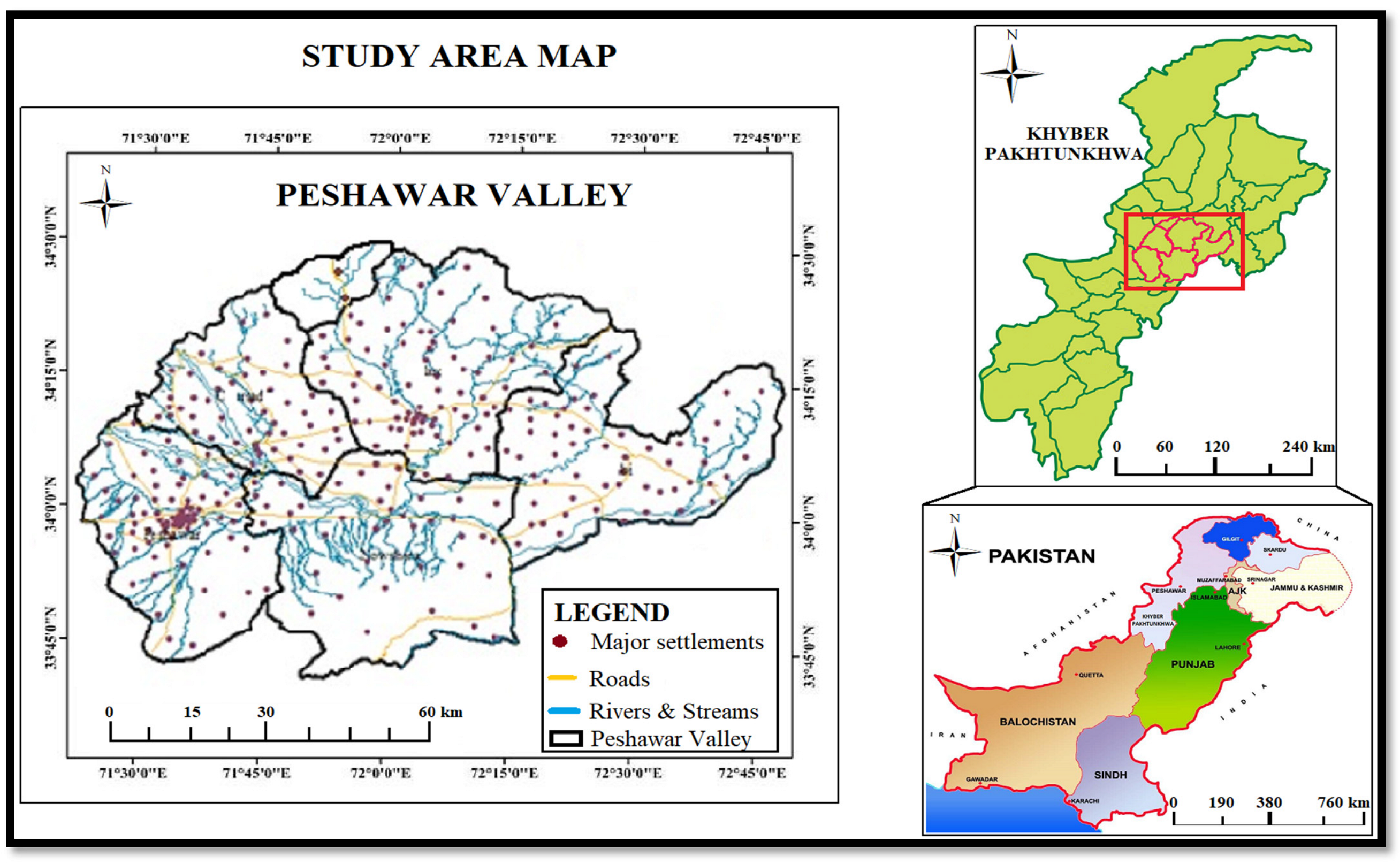
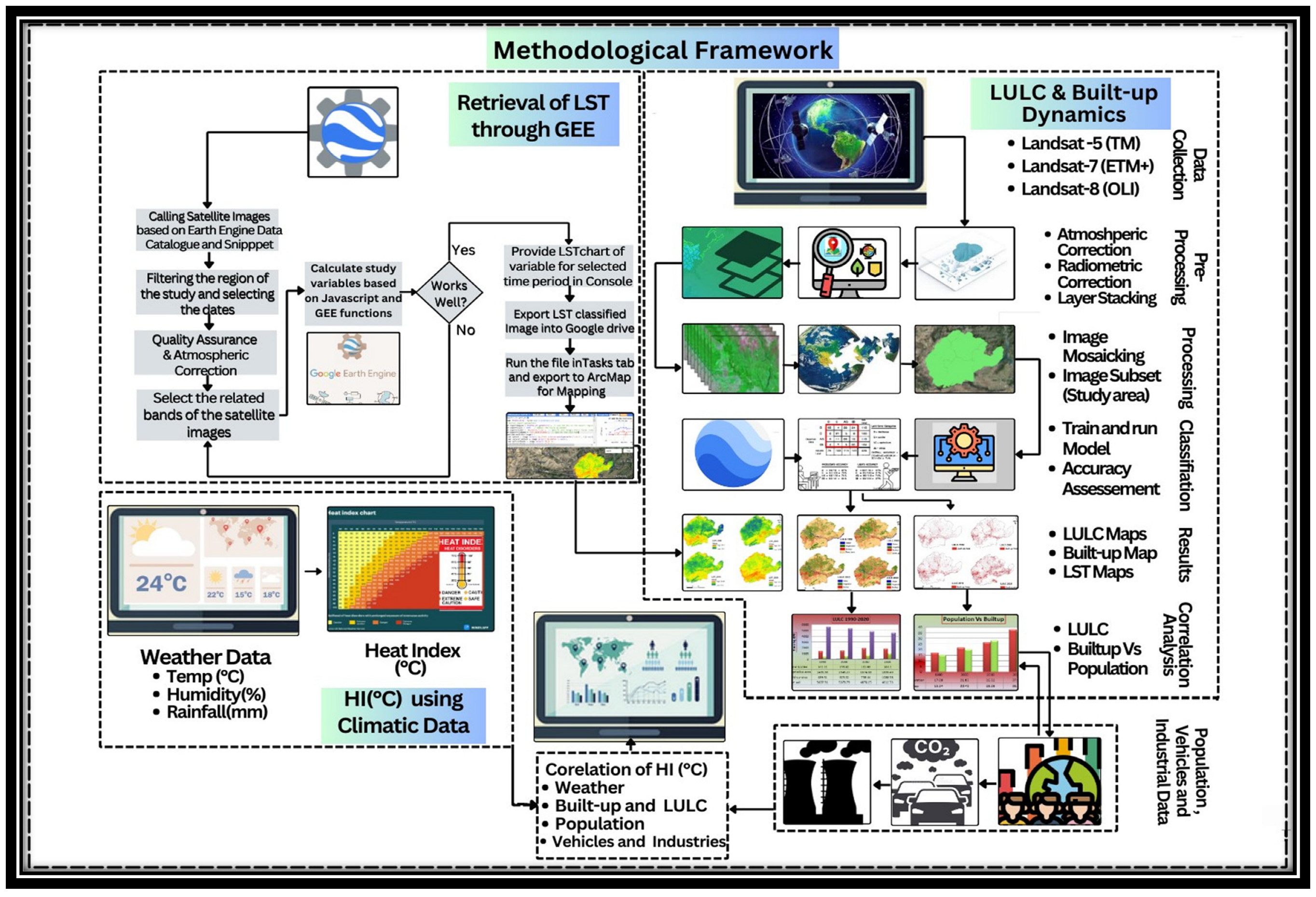

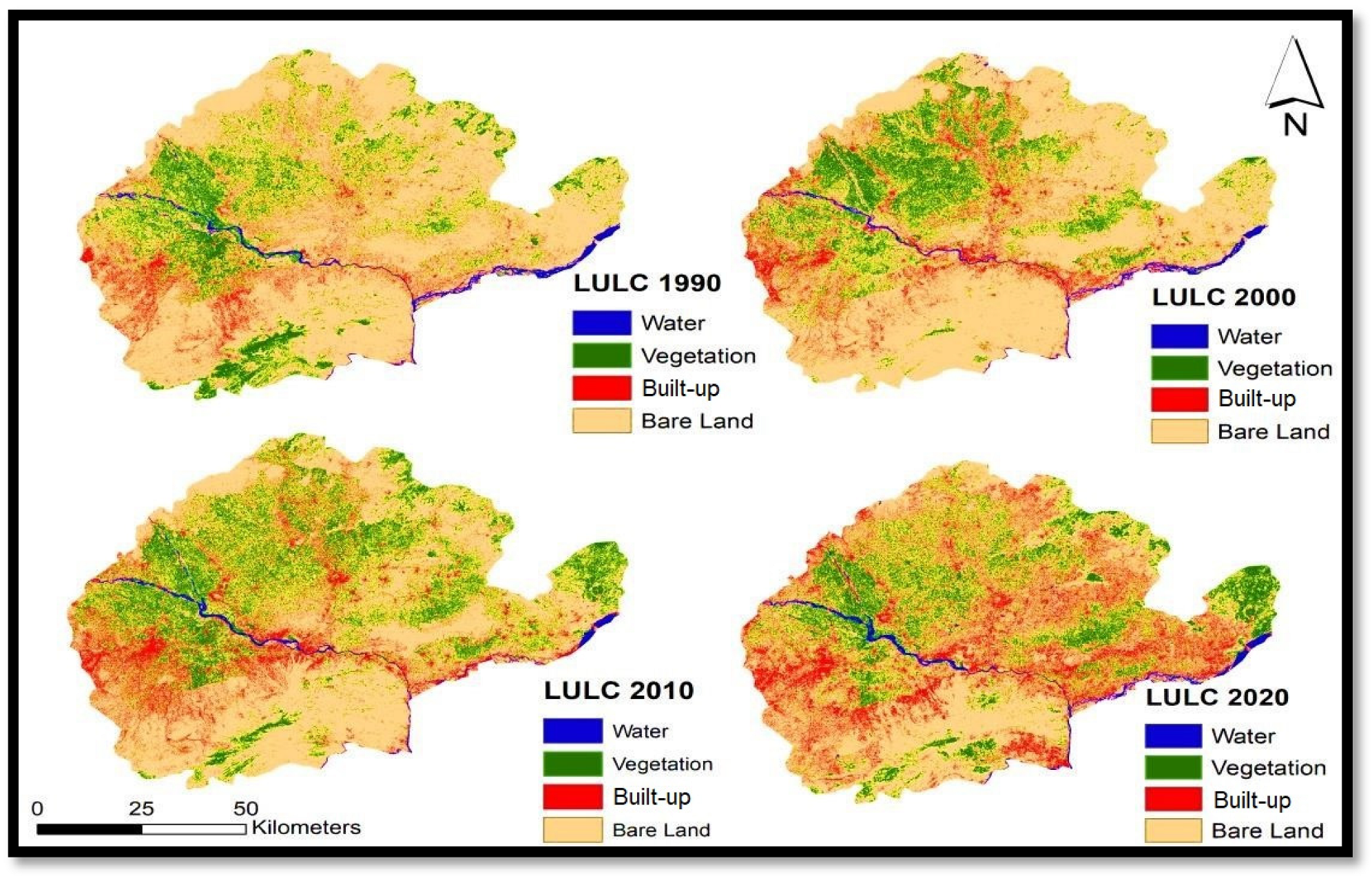

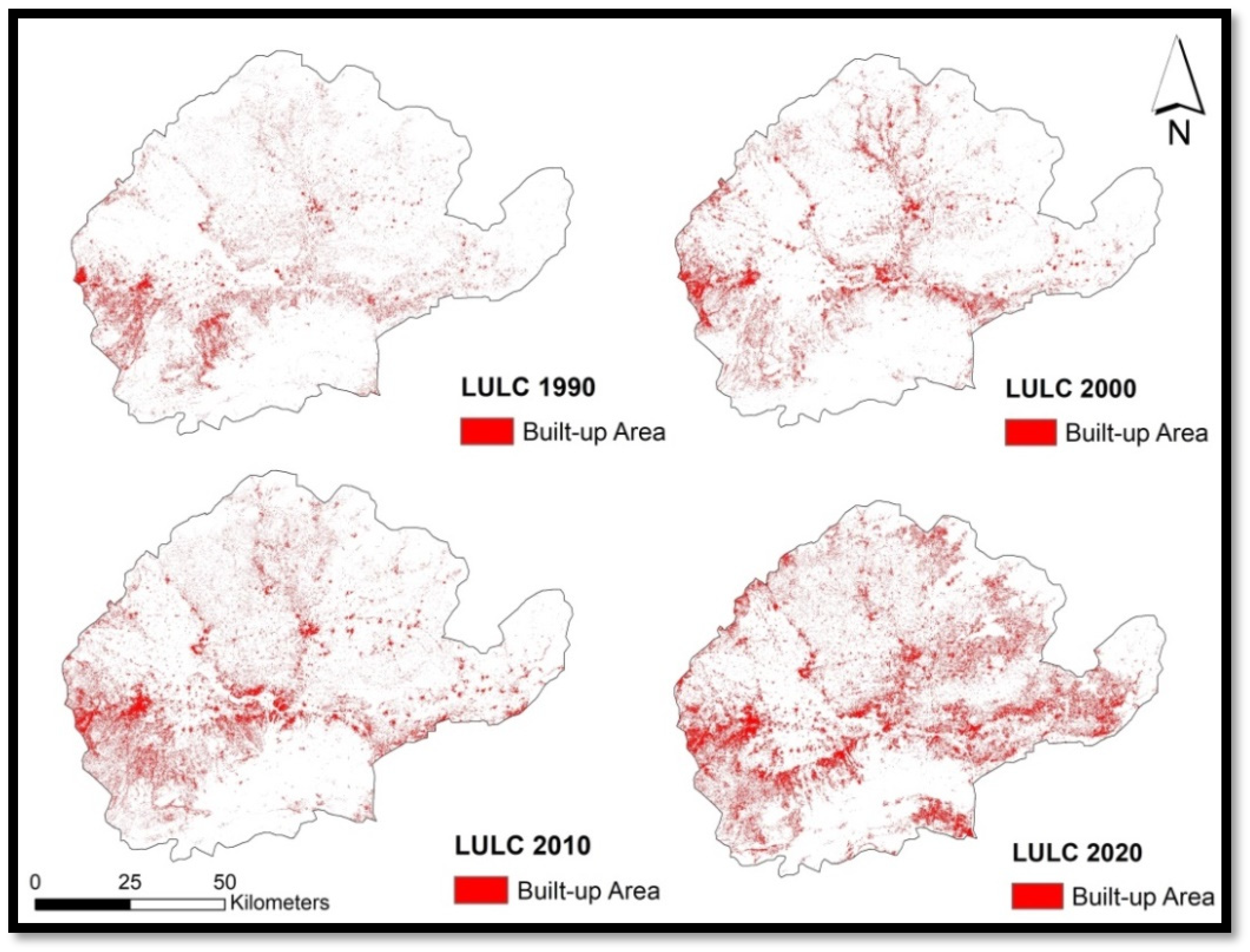

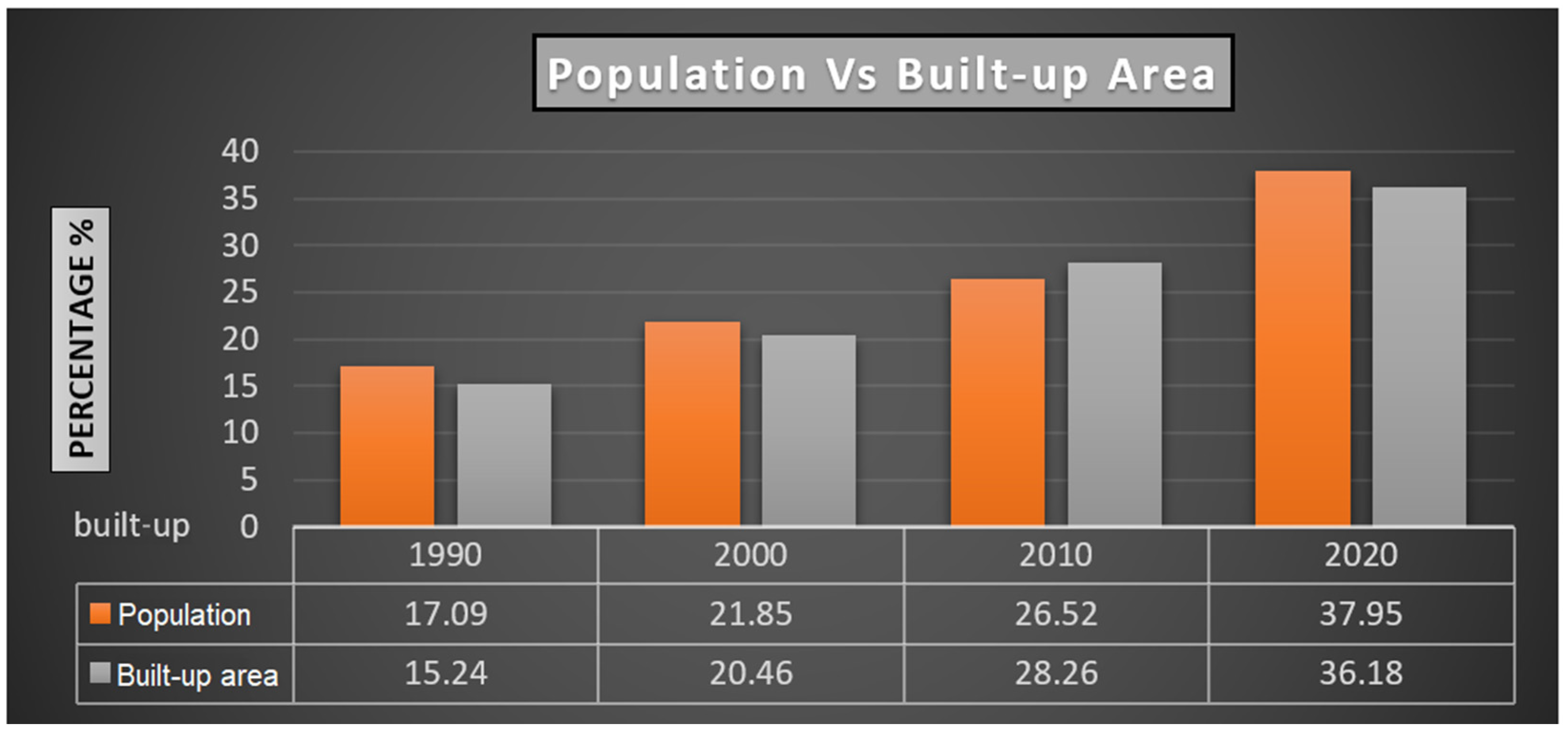
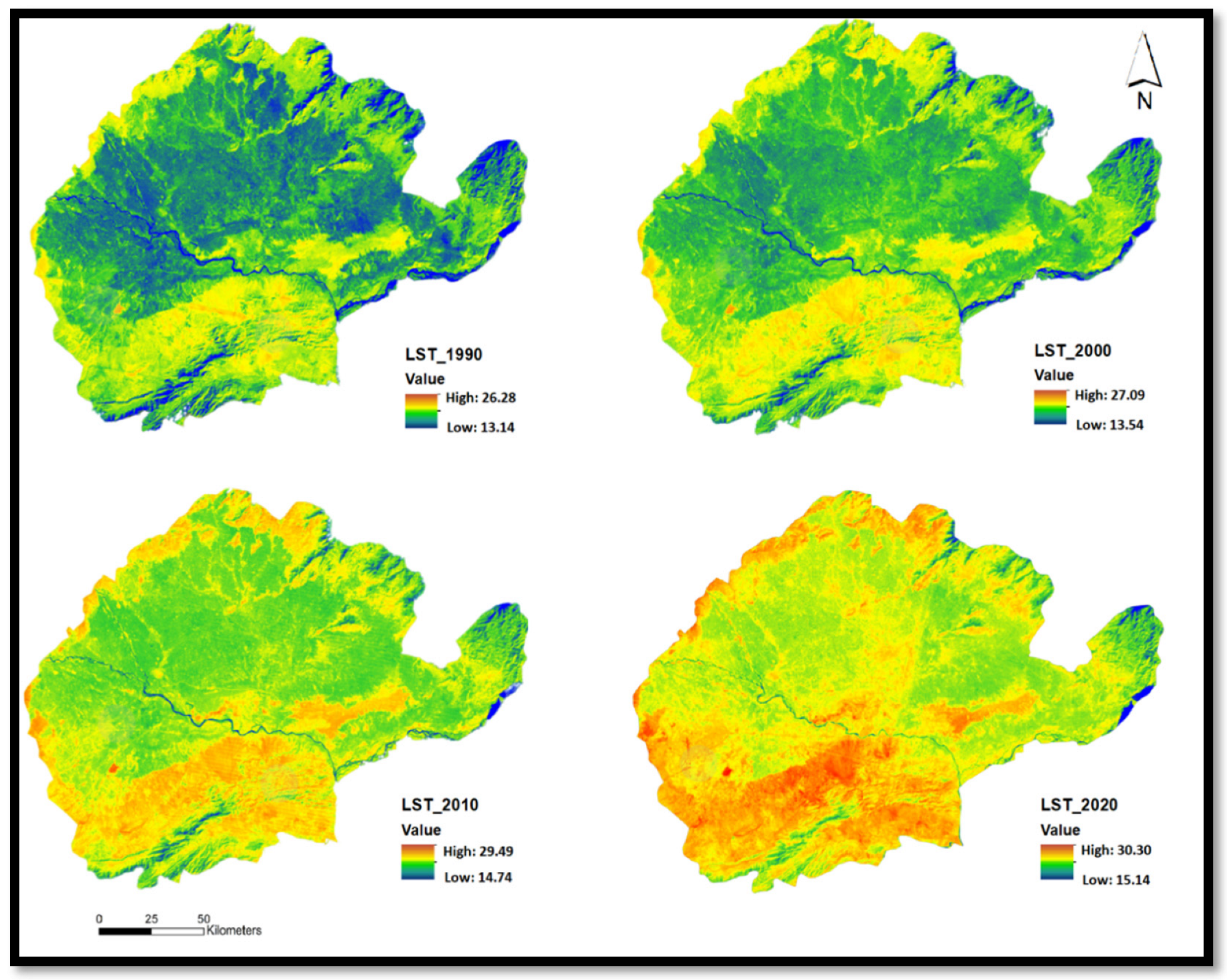

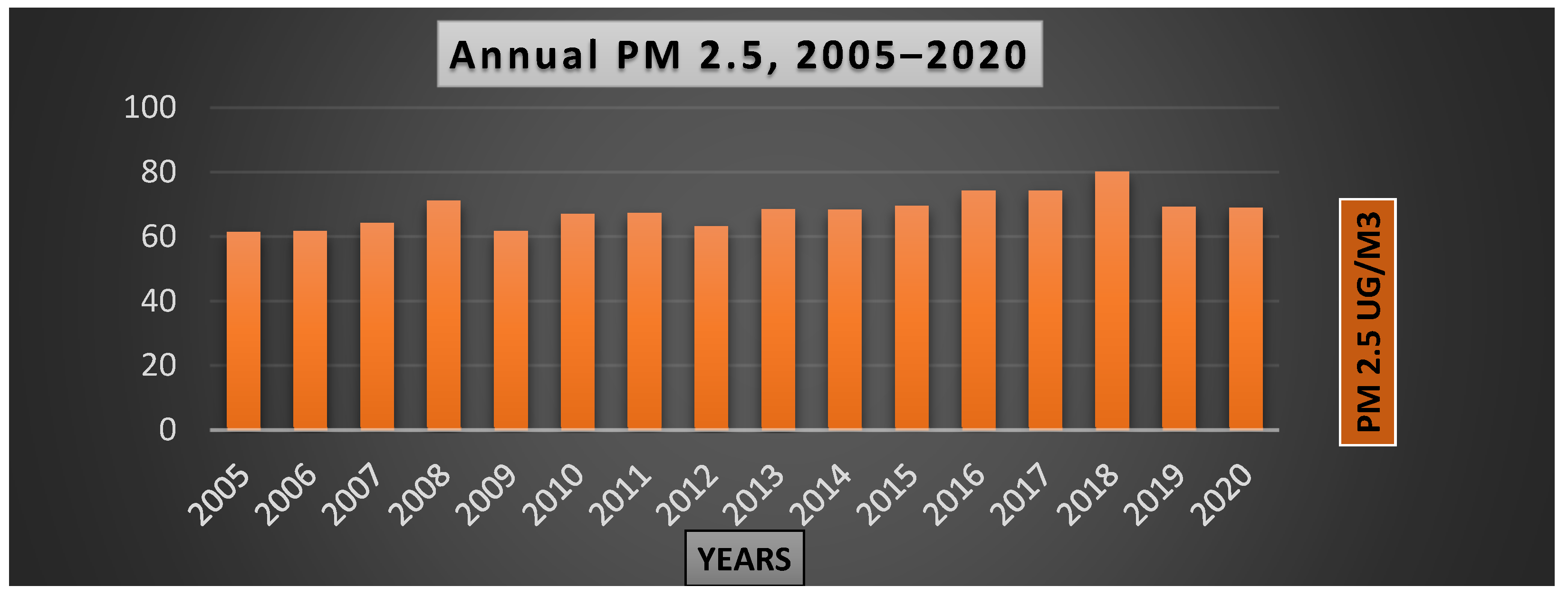
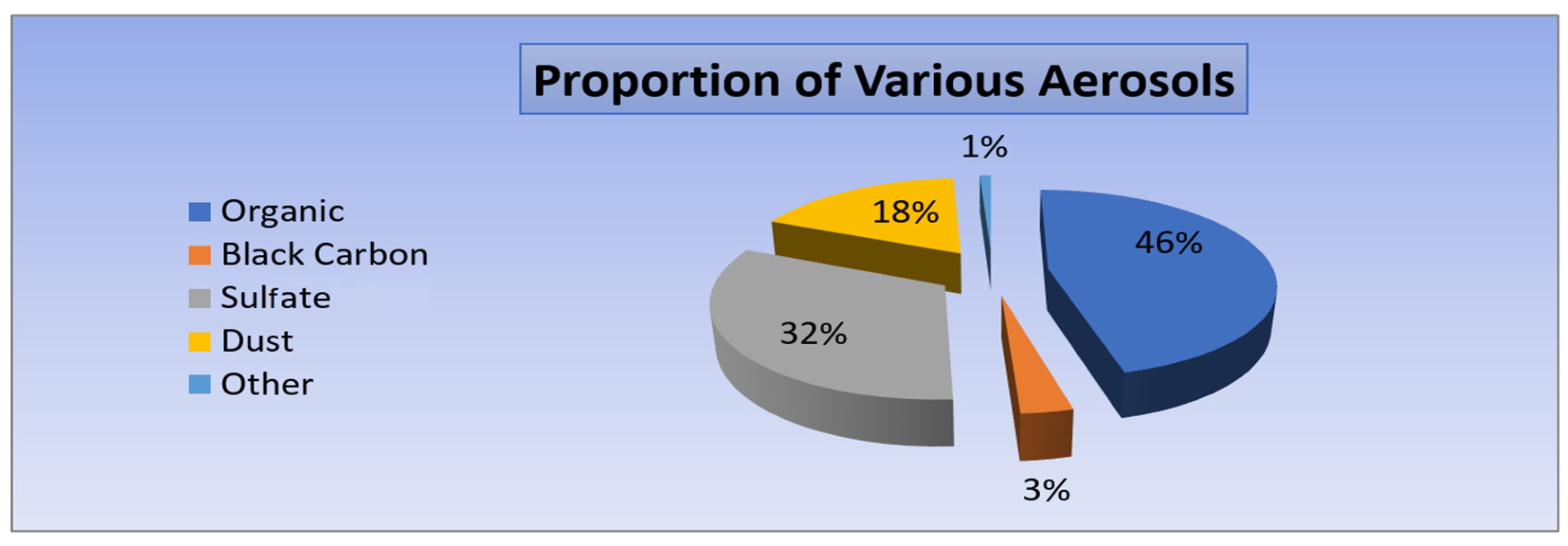
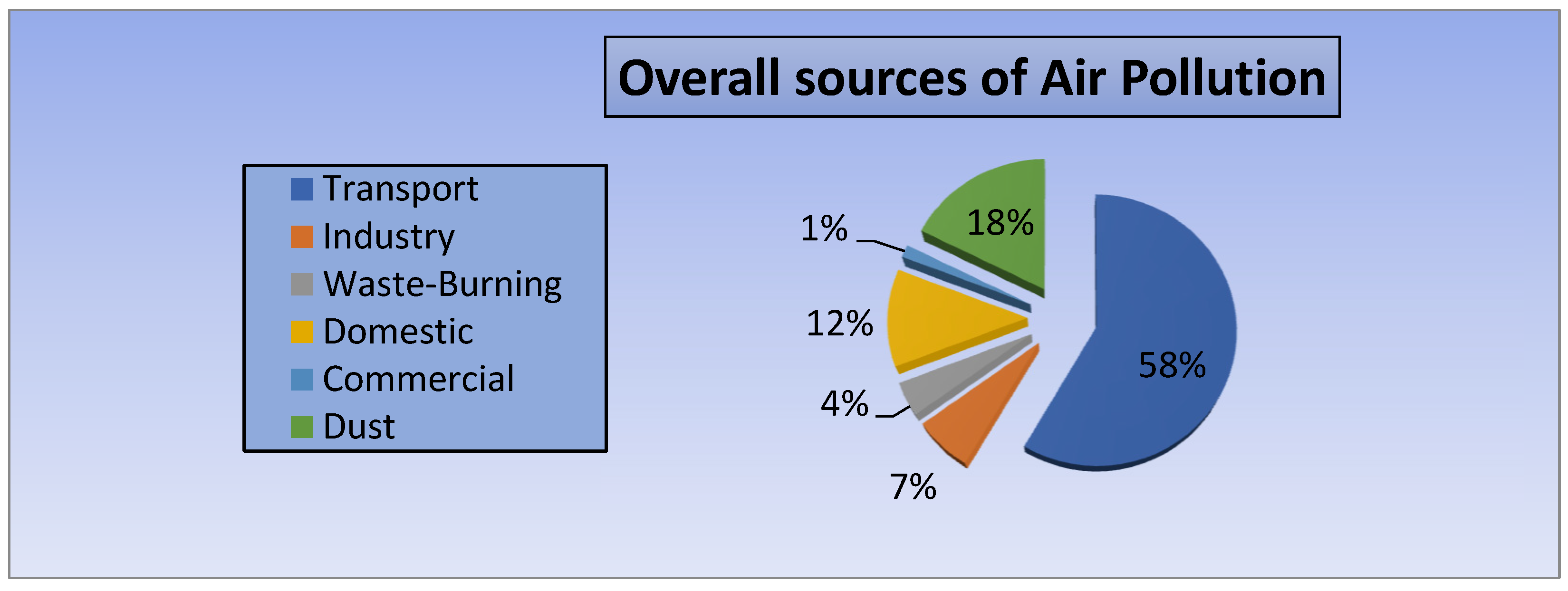
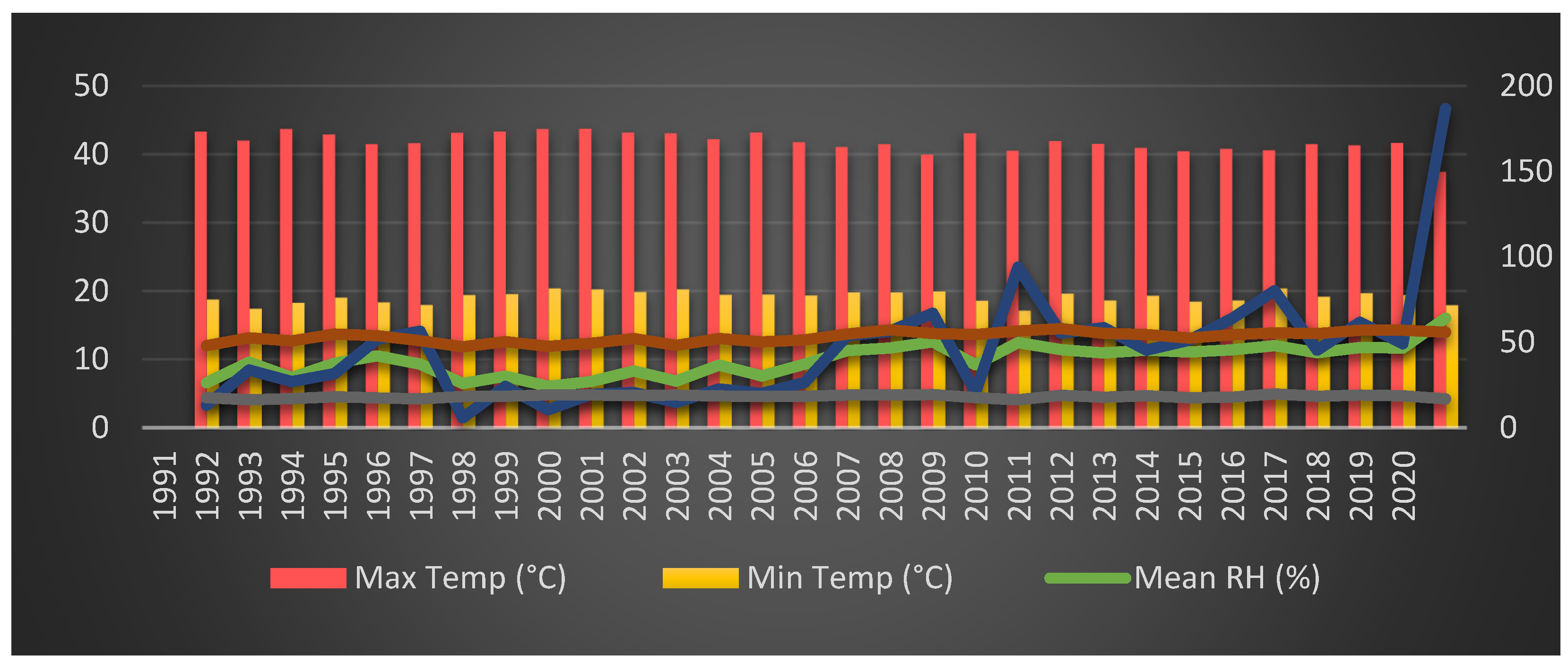
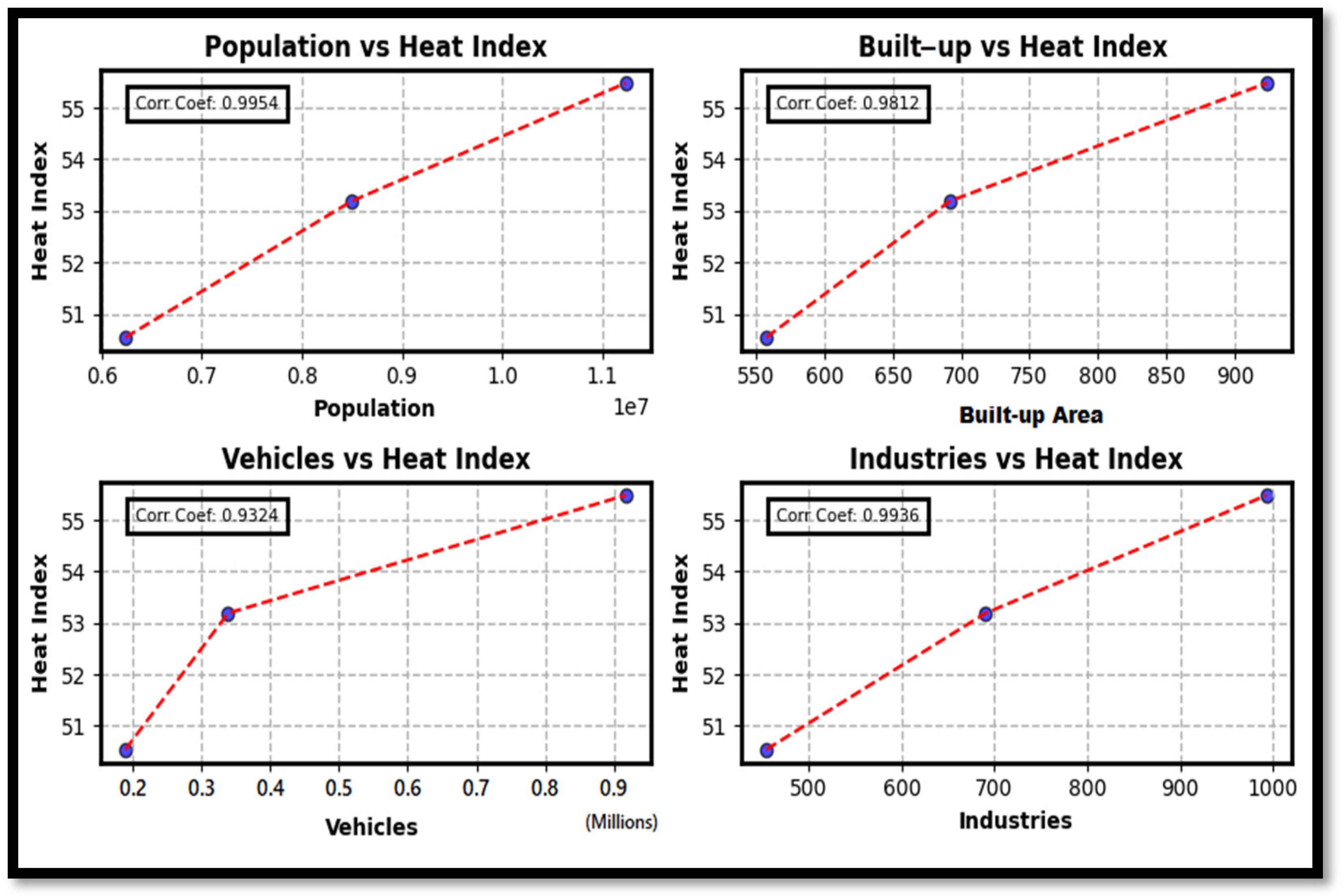
| Study Region | Row/Path | Year | 1990 | 2000 | 2010 | 2020 |
|---|---|---|---|---|---|---|
| Peshawar | 150/36 151/36 150/37 | Date | 2 and 27 June | 21 May and 13 June | 1 and 24 May | 20 and 29 June |
| Sensor | TM and ETM+ | TM and ETM+ | TM and ETM+ | OLI |
| Population Census | Total Population (million) | Year | No. of Registered Vehicles | No. of Industries |
|---|---|---|---|---|
| 1981 | 3.90 | 1990 | 170,637 | 327 |
| 1998 | 6.59 | 2000 | 208,959 | 394 |
| 2017 | 11.76 | 2010 | 469,459 | 907 |
| 2023 | 13.45 | 2020 | 1,364,718 | 1155 |
| HI (°C) | Level | Description |
|---|---|---|
| <27 | Normal | Fatigue from extended exposure. |
| 27 to <32 | Caution | Prolonged exposure or physical activity may result in fatigue. |
| 32 to <41 | Extreme Caution | Extended exposure and/or physical activity can result in conditions like heat stroke, heat cramps, or heat exhaustion. |
| 41 to <54 | Danger | Prolonged exposure to high temperatures or engaging in physical activities in such conditions can lead to heat cramps or heat exhaustion, and there is a potential risk of heat stroke |
| >54 | Extreme Danger | The likelihood of experiencing a heat stroke is substantial. |
| Land Cover Type | 1990 | 2000 | 2010 | 2020 | ||||
|---|---|---|---|---|---|---|---|---|
| PA (%) | UA (%) | PA (%) | UA (%) | PA (%) | UA (%) | PA (%) | UA (%) | |
| Water bodies | 90.9 | 100 | 94.1 | 96 | 85.5 | 94 | 95.9 | 94 |
| Vegetation | 100 | 90 | 95.9 | 94 | 93.3 | 84 | 94.1 | 96 |
| Built-up areas | 81.6 | 80 | 91.8 | 90 | 88.9 | 80 | 83.7 | 82 |
| Bare land | 80.3 | 82 | 90.2 | 92 | 81.8 | 90 | 82.4 | 84 |
| Overall accuracy | 89 | 93 | 87 | 89 | ||||
| Kappa coefficient | 0.85 | 0.91 | 0.83 | 0.85 | ||||
| LULC | 1990 | 2000 | 2010 | 2020 | ||||
|---|---|---|---|---|---|---|---|---|
| Sq.km | % | Sq.km | % | Sq.km | % | Sq.km | % | |
| Water bodies | 142.22 | 1.85 | 155.62 | 2.01 | 101.93 | 1.32 | 164.20 | 2.13 |
| Vegetation area | 1435.36 | 18.63 | 1545.27 | 20.05 | 1974.38 | 25.62 | 1839.49 | 23.87 |
| Built-up area | 489.51 | 6.35 | 625.32 | 8.11 | 758.44 | 9.84 | 1088.58 | 14.13 |
| Bare soil | 5637.91 | 73.17 | 5378.79 | 69.81 | 4870.25 | 63.20 | 4612.73 | 59.87 |
| Total | 7705 | 100 | 7705 | 100 | 7705 | 100 | 7705 | 100 |
| Land Use and Land Cover | Built-Up Area | Percentage Share (%) |
|---|---|---|
| Area in Sq.km in 1990 | 489.51 | 6.35 |
| Area in Sq.km in 2000 | 625.32 | 8.11 |
| Area in Sq.km in 2010 | 758.44 | 9.84 |
| Area in Sq.km in 2020 | 1088.58 | 14.13 |
| Change in area | 599.07 | 7.78 |
| Census | Total Population (million) | Year | Population (million) |
|---|---|---|---|
| 1981 | 3.90 | 1990 | 5.33 |
| 1998 | 6.59 | 2000 | 7.13 |
| 2017 | 11.76 | 2010 | 9.86 |
| 2023 | 13.45 | 2020 | 12.61 |
| Change from 1981–2023 | 9.54 | Change from 1990–2020 | 7.04 |
| Years | 1990 | 1995 | 2000 | 2005 | 2010 | 2015 | 2020 |
|---|---|---|---|---|---|---|---|
| No. Reg. Vehicles | 170,637 | 189,798 | 208,959 | 222,763 | 469,459 | 877,547 | 1,364,718 |
| No. Running Industries | 327 | 327 | 359 | 551 | 832 | 1007 | 1155 |
| Category | PM 2.5 Concentration (µg/m3) |
|---|---|
| Very Good | 0–10 |
| Good | 10–20 |
| Moderate | 20–25 |
| Poor | 25–50 |
| Very Poor | 50–75 |
| Extremely Poor | >75 |
| Year | Max Temp (°C) | Min Temp (°C) | RH (%) | RF (mm) | Max HI (°C) | Min HI (°C) |
|---|---|---|---|---|---|---|
| 1991–2000 | 42.94 | 19.009 | 31.789 | 27.366 | 50.54 | 17.81 |
| 2001–2010 | 42.01 | 19.431 | 39.308 | 39.597 | 53.19 | 18.48 |
| 2011–2020 | 40.86 | 19.189 | 47.397 | 69.71 | 55.48 | 18.35 |
Disclaimer/Publisher’s Note: The statements, opinions and data contained in all publications are solely those of the individual author(s) and contributor(s) and not of MDPI and/or the editor(s). MDPI and/or the editor(s) disclaim responsibility for any injury to people or property resulting from any ideas, methods, instructions or products referred to in the content. |
© 2024 by the authors. Licensee MDPI, Basel, Switzerland. This article is an open access article distributed under the terms and conditions of the Creative Commons Attribution (CC BY) license (https://creativecommons.org/licenses/by/4.0/).
Share and Cite
Hussain, M.F.; Meng, X.; Shah, S.F.; Hussain, M.A. Integrating Spatiotemporal Analysis of Land Transformation and Urban Growth in Peshawar Valley and Its Implications on Temperature in Response to Climate Change. ISPRS Int. J. Geo-Inf. 2024, 13, 239. https://doi.org/10.3390/ijgi13070239
Hussain MF, Meng X, Shah SF, Hussain MA. Integrating Spatiotemporal Analysis of Land Transformation and Urban Growth in Peshawar Valley and Its Implications on Temperature in Response to Climate Change. ISPRS International Journal of Geo-Information. 2024; 13(7):239. https://doi.org/10.3390/ijgi13070239
Chicago/Turabian StyleHussain, Muhammad Farooq, Xiaoliang Meng, Syed Fahim Shah, and Muhammad Asif Hussain. 2024. "Integrating Spatiotemporal Analysis of Land Transformation and Urban Growth in Peshawar Valley and Its Implications on Temperature in Response to Climate Change" ISPRS International Journal of Geo-Information 13, no. 7: 239. https://doi.org/10.3390/ijgi13070239
APA StyleHussain, M. F., Meng, X., Shah, S. F., & Hussain, M. A. (2024). Integrating Spatiotemporal Analysis of Land Transformation and Urban Growth in Peshawar Valley and Its Implications on Temperature in Response to Climate Change. ISPRS International Journal of Geo-Information, 13(7), 239. https://doi.org/10.3390/ijgi13070239





